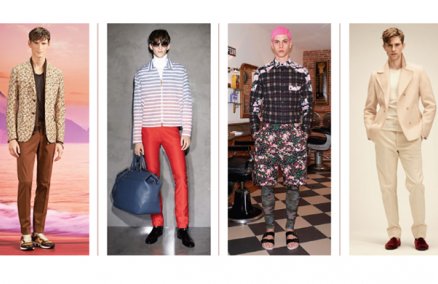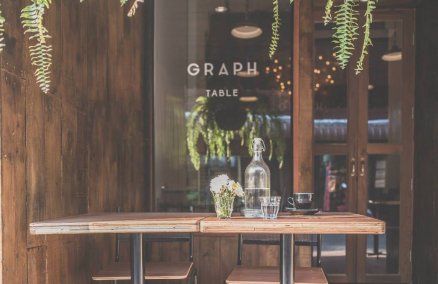Say the word shop house and most people think cheap noodle bars run by aunties, or a mom and pop store crammed with dried goods under an inch of dust. Are they doomed to disappear as everyone heads to the latest community mall? We spoke to brave entrepreneurs who set up shop the old fashioned way, in a house. Leaks, nasty neighbors and crazy landlords—you’ll see that personality comes at a price.
A SOULFUL JOINT
Shop house restaurants on Thong Lor are nothing new. The thoroughfare is lined with decades-old Thai, Chinese and Vietnamese restaurants. But the trend of late has been a shift towards community malls like J. Avenue and large development projects like 8 Thong Lo. That’s why Soul Food Mahanakorn, a stylish bar serving strong cocktails and small plates of regional Thai food is a little out of the ordinary. Opened this September, it’s located in an old, long-unused shop house just 100 meters from Sukhumvit Road and not a gleaming new community mall.
One in a long string of similar buildings, the space wouldn’t warrant a second glance were it not for the retro, brown and yellow sign and the moody, Scandanavian-style décor glimpsed through the large front window.In little over two months, Soul Food has managed to attract a loyal following of Bangkok’s young and beautiful who pack both floors on a near-nightly basis.
Walking into the long, wood-paneled, green-lamped room for dinner, you will almost certainly rub shoulders, literally, with large groups of them. The space often feels crowded and exciting. The man behind the operation, Jarrett Wrisley, a long-time food writer, sports studious thick-framed glasses, a five o’clock shadow and a warm smile. To him, it has to do with the size and shape of the place. “All the restaurants I like going to, whether in New York or Barcelona or Hong Kong, tend to be not very wide and they feel busy. I like that.”During the search for a space, Wrisley did also consider large houses. “I think a house would be very nice, but they tend to be further off the street,” he said. He knew what he didn’t want, though, which was to be in a mall. “The thing with having a restaurant in a mall is that the identity of the restaurant becomes tied to the mall. I don’t like eating in malls.”
Doing the research and legwork before deciding on this particular shop house was just the beginning. Traditionally built for residential living and small retail operations on the ground floor, most shop houses cannot readily accommodate the demands of a restaurant. Wrisley says, “People who live in shop houses probably would have one air conditioner running at a time. The wiring isn’t there, the plumbing isn’t there. I had to rewire the whole thing. Before the monsoon season, you don’t really have any idea. When it started raining, there were so many leaks.”
Long-vacant when Wrisley discovered it, this particular shop house had even less to work with. “It was basically a concrete box. There was nothing. The toilet was a little closet where the Coke fridge is right now.”
He ended up enlisting the help of his father, who works in the construction business in the United States. “We built the wood walls together, myself, my father and my chef Bun, and really, when you actually build something on your own you take a certain satisfaction in it that you might otherwise not have.”
One of the big structural changes Wrisley made to the building was to cut a hole into the floor of the second floor, creating a large opening where diners could look down into the main dining room. “I wanted people to know that there was a second floor up there—I needed some way to connect the first floor space with the second. Shop houses are very segmented by nature, and that seemed like a logical way to connect up and down.”
Even now, with the restaurant in full-swing, the work is hard. Wrisley arrives from his riverside home at 2pm most days and returns well after 1am, commuting an hour each way. Still, he prefers a separation between home and work life. “I wouldn’t want to live above my restaurant, because then I would never stop working.”
Soul Food Mahanakorn. 56/10 Sukhumvit Soi 55 (Soi Thong Lor), 085-904-2691. Open Tue-Sun 6pm-1am.
A STORY TO TELL
Like many great things, WTF is deceptively simple. It’s a café and a gallery. Nothing fancy. It’s a little rough around the edges, a little worn down. It evokes European cafes, but it could also be in Buenos Aires or Sydney. Still, it doesn’t feel foreign, unlike Minibar Royale or Hyde & Seek. Old records from Bangok’s funky 60s grace one wall. A touch of Sino-Portuguese tiles connects Europe to Asia. And the shell, a long narrow space with three floors, is unmistakably a shop house. Overall, WTF strikes a balance that’s pretty close to perfection.
“The design process was a lot of research on the internet, in design books, and coming up with a conceptual description, a way of telling a story,” says Christopher Wise, 49, a travel photographer and one of the four partners involved in WTF. That story is first and foremost the story of WTF’s partners and their diverse backgrounds. Wise is American, and married to fellow WTF partner, Somrak Sila, 31, who is a Thai arts manager with serious curatorial credentials. Another partner is Jorge Carlos Smith, 48, a Portuguese hotelier, who was behind Phuket Town’s fantastic restaurant and art space, the 346 Café & Gallery. The fourth partner is Kamonwan Seanissara, 30, a Thai advertising planner.
“Its was painful,” says Somrak of the process. “We went to all the places near Mochit, Chatuchak. Four months of brainstorming, looking for things, sketching, figuring things out. We managed to do it for only 600-700,000 baht including the deposit. But it was a lot of work, sweat and tears.”
Although they never considered being in a mall—too mainstream, too expensive—Somrak and Wise hadn’t set their minds on a shop house either.
“It started with the neighborhood, because we live nearby. Actually, we were thinking, ‘There are great shop houses in Chinatown.’ But we didn’t know if we could get foot traffic and we didn’t want to commute,” says Chris.
The rents they were offered varied wildly for identical venues, but they were wise enough to choose a shop house that ticks all the right boxes. For one, there’s parking owned by their landlord right behind them. Even more importantly, the shop house is open in the back.
“Air flow is very important,” says Somrak. “And light comes in from both sides. We’re really lucky.”
Of course, the shop house comes with limitations. The elongated shape of the building isn’t always ideal for the exhibitions on the second and third floors. And the space could be greatly improved if the building were just six inches wider, as people at the tables are nearly back to back.
“You also really need to worry about plumbing and electricity in a shop house. These places aren’t built to residential standards. The toilet just goes straight into the sewer, for example. There’s no bend in the pipe to block the smells from coming back up,” says Wise.
Somrak is quick to highlight two other very common pitfalls for anyone wishing to do business in a shop house: your landlord and your neighbors. “I couldn’t drill. They couldn’t stand it. It’s a drag for a gallery! We have to set up for events.” With the landlord, she was in for another surprise. They had signed with one of the landlord’s daughter, only to find out there were 13 siblings. “And they’re all nasty to each other and don’t want us to get along with the sister,” she adds.
They tried to create a sense of community, by inviting all their neighbors to events. Yet while WTF has created a community of artists, journalists, homesick foreigners and poets, people living in the shabby shop houses in WTF’s street never joined in.
“They were like, ‘Why are you doing this? Shop houses are to sell noodles. This will never work,’” says Somrak. “They came for the opening and that’s it. But now, a lot of designers and artists want to move in to this kind of place.”
WTF even has plans to expand across the street, into a bigger space that will have a more New York loft style. But whether they can really start a trend is far from sure. “You see Sukhumvit and the shop houses are getting knocked down all over the place,” says Wise. “And you have to wonder what’s going to happen to these places?”
WTF. 7, Sukhumvit Soi 51, 02-662-6246. BTS Thong Lo. www.wtfbangkok.com. Open Wed-Sun 6pm-1am.
A FAMILY AFFAIR
With its prime location in the old town close to Khao San, the boutique Old Bangkok Inn reflects another era and a more traditional lifestyle. So instead of cheap tea bags you’ll be served fine mulberry tea from Doi Tung and instead of basic amenities you’ll get a room decked out with vintage teak furniture, bone china tea sets and silk sheets and cushions.
“It’s been more than five years and we’re just glad we’re still going strong,” says Nantiya Tulyanond about the hotel, which she started with her son Jirayu, who also has a day job as assistant to Finance Minister Korn Chatikavanij. The family travels a lot, especially in Europe and it was while staying in a beautiful Normandy chateau that they got their inspiration for this shop house project.
“The Count who owned the chateau has had to open three or four rooms for visitors to generate some income, yet he takes care of everybody as if they were his house guests,” explains Nantiya. “He even took us to his family’s tombs. After this visit we decided to open our own little hotel when I retired.”
But instead of starting with a brand new building, Nantiya and her son chose to renovate two of her family’s 100-year-old shop houses, which were previously being rented as noodle shops. Located behind the Queen’s Gallery, within walking distance to Democracy Monument, the family was confident about the location.
“We ended up spending around B10 million on the renovation. It’s a lot more than if we built new, but we consider this an investment in part of our own history.”
Nantiya warns that renovating a shop house can give you a complimentary daily headache. She also points out that it takes even more effort to keep it maintained once the renovation is finished. For example, the shop houses of Old Bangkok Inn are made from hundred-year-old wood and cement, which results in problems like rain leaking in at different spots every year. “You just have to prepare for this—it’s the nature of an old building,” explains Nantiya with a shrug.
When asked whether she would repeat the experience she already has a ready-made answer. When the hotel decided to expand she simply chose to renovate the shop house next door creating two impressive new suites complete with outdoor bathtubs and a tree house.
A good location is clearly a driving force for these choices but it’s obvious that family ties are equally important. “Living in a place that belonged to our family means you don’t need to adjust yourself so much. That’s different to moving into a new space. We didn’t live here before we built the hotel, but our ancestors did, so it feels familiar.”
Old Bangkok Inn. 609 Pra Sumen Rd., near Queen’s Gallery, Pra Nakorn, 02-629-1787. Rates are B3,190-6,590. www.oldbangkokinn.com.
A NEW NEST IN AN OLD PART OF TOWN
Soi Charoen Krung 37 might be one of the last places in Bangkok where you’d expect to find a contemporary-looking hotel—it’s so small cars can’t even pass through; it’s as messy as a market; and so local that grumpy grandpas sit topless at their front doors. But situated at the end of the soi you’ll find Bangkok’s newest boutique hostel, The Chilli Bangkok.
“The best thing is it means our guests can get a glimpse of real Bangkok life,” explains Summer Dhippanuratana, the hotel’s director. “You just cannot find this location elsewhere. I spent three years searching for a building like this, an old building away from noisy streets but located at the center of downtown with easy access elsewhere.”
Summer certainly knew what she wanted, and having travelled extensively herself, what kind of demographic she wanted to appeal to. “Budget travelers are less affected by economic fluctuations,” she points out as way of explaining why she chose to open a hostel. But as a traveler herself, Summer believes that doesn’t always have to mean low quality.
After stringent engineering and architectural tests to ensure the strength of the structure, three 30-year-old shop houses were merged into one single building to create this 24-room hostel. The results are impressive. Walls have been knocked down to create an airy atrium, complete with plants, that allows natural light and breezes to circulate. The small rooms all have tiny ensuite bathrooms and the bare concrete walls are softened by clever lighting and splashes of color.
The first step in the renovation process was to rip out the old electrics and plumbing and do the whole thing again. Summer says it does save time in the long run. “These are the most likely things to cause you big troubles later on if you try to use the existing systems. We also had to learn as we went. For example, you need to employ special techniques to paste new cement onto old cement.”
While it might seem that the renovation itself is the biggest headache it seems that dealing with the local community was even worse. “We have to understand that we’re the newest arrivals among old-time residents. So everything we did received negative response at first. I spent months having to talk to people, negotiating with them to accept that this new development wouldn’t threaten their traditional lifestyles.”
A total of thirty million baht has been invested and Summer projects a return in eight years. It’s only be opened for just one and a half month but there have been several travelers who have promised to come back. It’s a competitive market, though. “There are so many cool hostels out there. Each has its own different character so at the end of the day, hospitality and service make the difference. You might have loads of money to renovate old shop houses, but if you don’t have a service mind and cross-cultural understanding, don’t do a hotel.”
The Chili Bangkok, 53/15 Charoen Krung Soi 37, 02-639-5707. www.thechillibangkok.com.
A DARK PLACE
Iron Fairies started out as a fairy factory three years ago—craftsmen and women bent over little steel figurines of winged girls and steampunk satchels of bolted leather—and that’s still what goes on here during the day. The fairies have their own tale, which is kept in a massive steel press of a book on the uppermost floor. But to us mortals, Iron Fairies is mostly just a great bar, one that also serves a mean burger.
“I’d be in here, and we’d be making fairies, and people would drop by and have a drink. The place was very much as it is now, minus the bar back there,” says Irony Fairy master Ashley Sutton. “So eventually, I decided to open the place up in the evening.”
Iron Fairies is one of the most exciting, most original, most gothic and bizarre places in Bangkok. As a workplace, it reminds us of Charles Dickens’ novels: everything is dark, crumbling, aged, with chunks of steel and heavy bolts keeping it all together.
“The landlord thinks it’s all going to crash through the ground floor. I’m not sure what law of physics makes her think that’s possible,” says Sutton. Tattoos crawl up his neck, he’s dressed a bit like a cowboy and he looks at you so intently it’s unnerving. He’s pissed off at the landlord, at the neighbors, at cell phones and his staff. So we’re not going to contradict him. But it does look like a ton of steel sitting in a precarious brick shell might not be such a hot idea.
“They want me thrown out. They look at what I’ve done to the place and they think it’s crap. The massage place next door has tiles. Now tiles, that looks nice!” he says, sneering. “But I’m not moving out. I don’t even know how much I spent on this place. It’s not the money. It’s the time. I did everything here.”
Iron Fairies doesn’t look like a building so much as an intricate sculpture. A winding staircase climbs up from the entrance towards a little balcony and stage. When we get there, before opening hours, the fairy workers are packing up. You literally are eating and drinking on what serves as a workbench during the day. Unfortunately, no amount of fairy dust can magically turn a shop house into a practical commercial space.
“You’ve got the neighbors and the landlord. But then you’ve got the plumbing, everything. The construction is a joke. This floor we’re on right now, it’s a roof. It’s not meant to be built on. I put the pipes through the walls myself and, trust me, what you see is scary.”
Interestingly, Sutton can describe both what it is like to convert a shop house and what it’s like to operate within the clean, gleaming, modern confines of a community mall as he’s just opened Fat Gut’z Saloon at the neighboring Grass mall.
“Shop house versus community mall? Mall, definitely. If I did this again, I’d meet my neighbors first, and I’d make sure my contract is really solid.”
Iron Fairies. 395 Sukhumvit Soi 55 (Thong Lor), 084-520-2301. Open daily 6pm-2am.
NEW OLD FASHION
Phuket Town, the Southern Thai restaurant on the corner of Thong Lor Soi 6, is an all-out throwback to yesteryear. The deep yellow facade with hanging pewter lanterns and a narrow darkwood door is a mash-up between Morocco and the eponymous beach town’s old Baba neighborhood. Inside, the prominent wall-sized mural depicting a row of colorful Phuket Town shop houses and the retro bric a brac—an old Chinese abacus, Sino-Portuguese wallpaper, a dark cabinet full of trinkets, an old clock—all underline the theme of playful nostalgia.
The restaurant is also a throwback because, aside from the faux-retro touch of the decor, it is not trying to be pretentiously cool yet manages to get regular traffic serving food that is no-frills and is solidly Thai, inexpensive and delicious, qualities we expect of much older institutions in the Thong Lo stretch.
But perhaps the truly revolutionary part of the whole story is that the young owner and manager, Kate Kiattikul, in the tradition of old shop house inhabitants, lives in the building, in a room on the fifth floor, while two of her chefs live on the third floor. “Rent is quite high around here, and I wanted to stay in the area. I didn’t want to commute to my house, which is pretty far away. I work from 10am to 11pm, so I wouldn’t have had any energy left.”
At first glance, or even third, she really doesn’t seem the type to live above a shop house. “I had just gotten back from studying in the UK, and then I had nothing to do, so I was looking for an opportunity. I graduated in management, and my family has a food background.” She’s young, petite and pretty, with long hair dyed a reddish color—a well-off, stylish, modern girl we don’t imagine living on the same premises as her business, in the style of old Chinese uncles.
She confesses she investigated community malls in the area for a restaurant space. “Too expensive,” she says. “But I wanted to have a restaurant here. When people go out to eat, they go to the Thong Lor, Ekkamai area. It’s a good opportunity to do this kind of food, because it’s served super cheap and the restaurants don’t have air-con.”
But it’s not just a matter of financial practicality for Kate, because, after all, fixing up and maintaining a shop house hasn’t been easy. “The construction is pretty old, and I have to fix it all the time. There are quite a lot of problems. I have to fix the electricity, and the water system is very bad. We use water a lot, because we’re a restaurant, so the pipes broke. I had to pay for that. The wall was damaged last week. And there’s very little parking.” There’s also a streak of old-school soulfulness in Kate. We asked what she would do if she could have the restaurant at 8 Thong Lo, the big spiffy development up the street. “I would stay in this building, because I can take care of it. I can live here. It looks more individual, not like franchises. And the reason why I didn’t choose a place bigger than this is because I wouldn’t be able to take care of my customers.”
Which is not to say it’s all in the name of a principled sacrifice. Living above Phuket Town has its social advantages, too. “I’ve made the room quite cozy, and it’s easy to meet up with my friends,” says Kate, smiling.
Phuket Town. 160/8 Sukhumvit Soi 55 (Thong Lor), 02-714-9402. Open daily 10:30am-10pm.
• Read tips on how to decorate a shophouse from Ekkapong Tritrong, Head of the Faculty of Decorative Arts, Silpakorn University.
• Read tips on how to decorate a shophouse from Ekkapong Tritrong, Head of the Faculty of Decorative Arts, Silpakorn University.

























